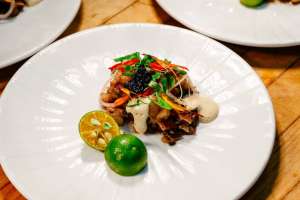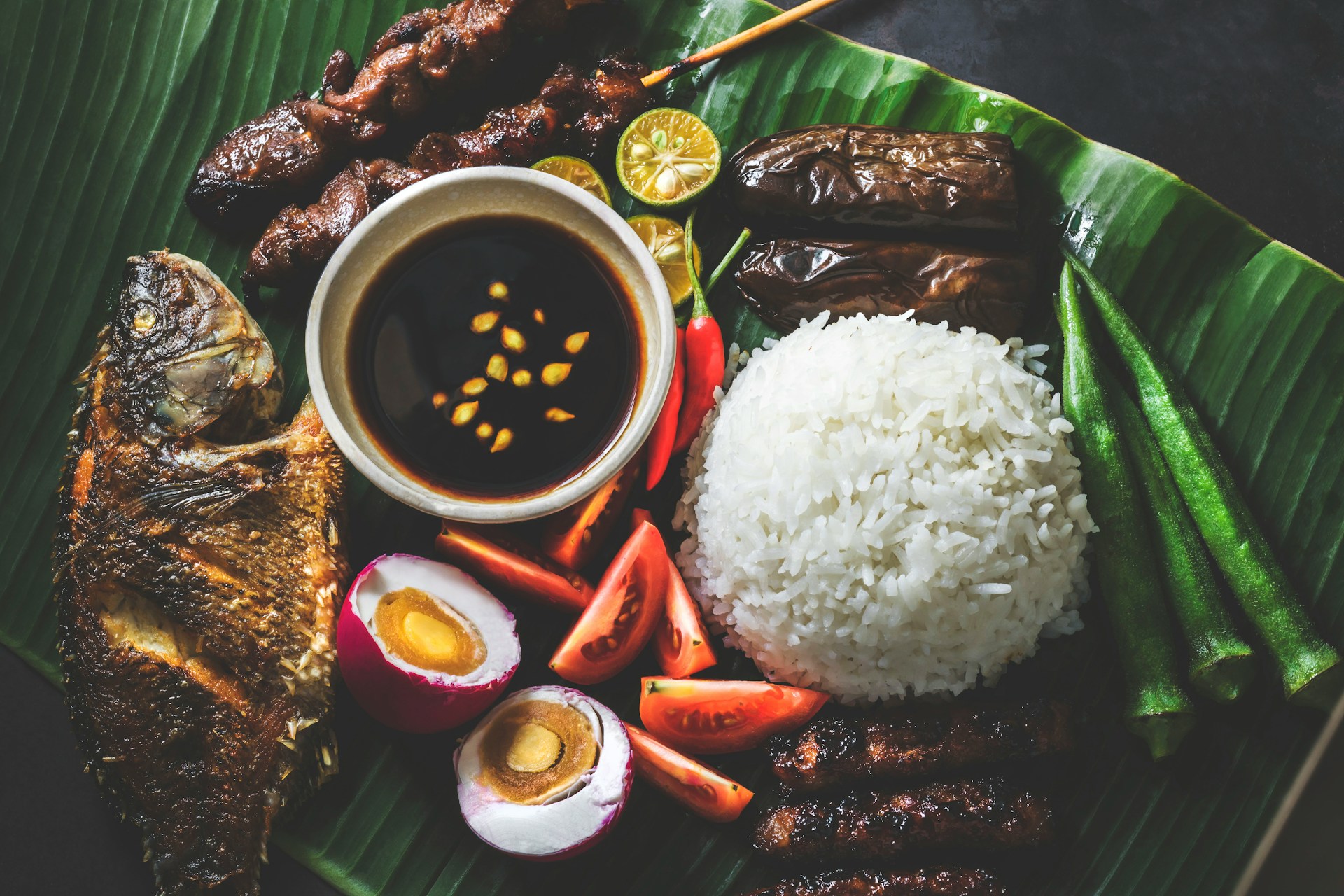Okay, let’s talk about two of my favorite things: wine (obviously)…and eating incredibly well. And when it comes to pure, unadulterated flavor joy, Filipino food is top 10, no question. But you know what often gets left out of the kainan (feast)? What to sip alongside that glorious adobo or tangy sinigang. Beer and soda are classics, sure, but exploring wine pairings? That opens up a whole new world of deliciousness.
Filipino cuisine is a vibrant tapestry – think salty, sour, sweet, savory, and sometimes even funky, often all on the same plate. It’s bold, it’s comforting, and it deserves a thoughtful drink companion. Forget rigid rules; pairing wine is about harmony, contrast, and lifting the experience. After plenty of trial and error (and happy accidents!), here’s my practical take on pairing Filipino foods with wine.
Here are my six general rules for Filipino Food and Wine pairing.
- Acidity is Your Ally: Filipino food often has bright acidity (think sinigang, kilawin, vinegar in adobo). Wines with good acidity cleanse the palate beautifully. Think Riesling, Pinot Grigio, Sauvignon Blanc, Gamay, or even Barbera.
- Sweetness vs. Sweetness: Dishes with noticeable sweetness (like some adobo styles or bistek) can clash with very dry wines. Slightly off-dry wines can be magical here, offering a counterpoint without competing.
- Match Maker: Match the wine’s body (light, medium, full) to the dish’s richness. Hearty stews like kare-kare need more oomph than a light ensalada. Don’t drown a delicate fish sinigang with a heavy Cabernet.
- Chill Out (Often): Especially in the Philippine heat, and with many Filipino flavors, whites, rosés, and lighter reds served cool are incredibly refreshing and palate-cleansing. Don’t underestimate a good, chilled Gamay or Pinot Noir.
- Embrace the Funk (Carefully): Fermented shrimp paste (bagoong) and fish sauce (patis) add unique depth. Wines with a bit of fruitiness or earthiness (like Pinot Noir or certain Gamays) can bridge that gap better than super-delicate whites.
- Spice Consideration: Dishes with chilis (like Bicol Express) need wines that won’t amplify the heat. Avoid high-alcohol wines and tannic reds. Off-dry whites (Riesling!) or fruity, low-tannin reds like Beaujolais are safer bets.

Alright, let’s get to the good stuff – the pairings!
1. Adobo (Chicken or Pork)
The national comfort food. Salty, tangy, savory, sometimes slightly sweet. That garlicky, vinegary sauce is key.
My Top Picks:
Off-Dry Riesling (Kabinett/Spatlese) – The touch of sweetness harmonizes with any caramelization or slight sweetness, while its zippy acidity cuts through the fat and mirrors the vinegar.
Gamay (Beaujolais Village or Cru) – Light-bodied, fruity (red berries), low tannins, and refreshing acidity. It complements without overpowering.
Bonus Tip: A Rosé with good acidity can be surprisingly delightful.
2. Sinigang (Sour Soup – Pork, Shrimp, or Fish)
That signature tamarind (or other souring agent) punch! It’s tangy, savory, often with tender meat or seafood and veggies.
My Top Picks:
Unoaked or Lightly Oaked Sauvignon Blanc – High acidity is essential to match the sourness; the grassy/citrus notes of Sauvignon Blanc feel clean and refreshing.
Dry Riesling – Similar acidity punch, often with lime/stone fruit notes that complement the broth.
Seafood Sinigang Bonus: A crisp Pinot Grigio works wonders too.
3. Lechon (Roast Suckling Pig)
The king of fiestas! Crispy, crackling skin, succulent, fatty meat. It’s rich, savory, and celebratory.
My Top Picks:
Cava or Champagne (Brut) – The bubbles and acidity cut through the fat spectacularly, cleansing the palate for the next glorious bite.
Cru Beaujolais (Morgon, Fleurie) – More structure than basic Beaujolais, with vibrant fruit and acidity that handles richness well.
Hearty Option: A Tempranillo (Crianza)– Good acidity, red fruit, and earthy notes can stand up to the pork.
4. Kare-Kare (Oxtail & Tripe Stew in Peanut Sauce)
Rich, nutty, savory, slightly sweet, and often served with salty bagoong. It’s a textural and flavor powerhouse.
My Top Picks:
Off-Dry Gewürztraminer – The lychee/rose/ginger spice notes complement the peanut sauce beautifully, and the touch of sweetness balances the sauce’s richness and the bagoong’s salt. Chardonnay (Oaked) – Look for balanced Californian examples. The weight matches the stew, and subtle oak/vanilla notes can echo the peanuts.
Red Option: A Pinot Noir with earthy undertones can work if it has enough fruit and acidity.
5. Crispy Pata (Deep-Fried Pork Knuckle/Hock)
All about that incredible crunch, juicy meat underneath, and serious richness. Fatty and intensely savory.
My Top Picks:
Dry Rosé (Especially from Southern France or Spain) – Refreshing acidity cuts the fat, a hint of red fruit complements the pork.
Dry Riesling – Again, high acidity is key for cleansing.
Bubbly Option: Prosecco (Brut) – Lighter bubbles than Champagne, but still effective.
6. Bistek Tagalog (Beef Steak with Onions & Calamansi)
Salty, savory, tangy (from soy sauce and calamansi), with sweet caramelized onions. Relatively straightforward flavors but robust.
My Top Picks:
Pinot Noir – The go-to for a reason. Versatile, red fruit flavors, good acidity, light tannins. Complements without overwhelming.
Barbera d’Alba/Asti – Italian red known for high acidity and low tannins, packed with juicy cherry fruit. Perfect for the soy-calamansi tang.
Value Pick: A juicy Grenache/Garnacha from Spain can also hit the spot.
7. Pancit (Various Noodle Dishes – e.g., Bihon, Canton)
Often a mix of savory, slightly sweet, with veggies, meat, seafood. Can range from light (pancit bihon) to richer (pancit canton).
My Top Picks:
Dry Riesling – Versatile acidity works with most versions.
Pinot Gris/Grigio – Clean, crisp, neutral enough for varied flavors.
Rosé – A crowd-pleasing middle ground.
For Richer Pancit Canton: A light-bodied Gamay can be fun.
8. Lumpia (Spring Rolls – Fresh or Fried)
Lumpiang Sariwa (fresh) is veggie-forward, often with peanut sauce – think crisp textures and savory/sweet sauce. Lumpiang Shanghai (fried) is meaty, savory, crispy.
My Top Picks (Sariwa):
Off-Dry Riesling or Chenin Blanc (Sec-Tendre) – Touch of sweetness loves the peanut sauce.
Dry Rosé – Complements the fresh veggies.
My Top Picks:
Cava/Prosecco (Brut) – Bubbles + acidity = perfect fried food foil.
Sauvignon Blanc – Zesty acidity cuts the grease.
9. Chicken Inasal (Grilled Chicken with Annatto & Calamansi)
Charred, smoky, tangy, slightly sweet/vinegary from the marinade. Vibrant yellow hue.
My Top Picks:
Albariño – Spanish gem: zesty acidity, citrus/peach notes, saline touch – loves the char and tang.
Dry Rosé – Again, the acidity and red fruit work beautifully with grilled flavors.
Light Red Option: A chilled Frappato offers bright red fruit and low tannins.
10. Bicol Express (Pork/Shrimp in Coconut Milk & Chilis)
Creamy, spicy, savory, rich. The coconut milk mellows the heat somewhat, but it’s still a kick.
My Top Picks:
Off-Dry Gewürztraminer – The slight sweetness counteracts the heat, the lychee/spice notes complement the coconut and chilis.
Off-Dry Riesling – Similar reasoning; Riesling‘s acidity balances richness.
Avoid: High-alcohol wines and tannic reds – they’ll make the heat feel hotter!
11. Kinilaw (Filipino Ceviche – Raw Fish in Vinegar, Citrus, Ginger, Chilis)
Bright, acidic, fresh, spicy, with clean ocean flavors.
My Top Picks:
Muscadet Sèvre et Maine Sur Lie – Bone-dry, mineral, crisp, with a slight yeasty tang – perfect for fresh seafood and acidity.
Sauvignon Blanc – Razor-sharp acidity and citrus/herbal notes mirror the dish flawlessly.
Simple Option: A super-chilled Pinot Grigio.
Wrapping Up the Filipino Food and Wine Fiesta

Look, Filipino food and wine isn’t about finding one “perfect” bottle dictated by some fancy rulebook. It’s about exploring, experimenting, and finding what makes your taste buds sing. I’ve had some truly fantastic moments sipping a chilled Gamay with simple garlic rice and fried egg (garlic silog), or discovering how well a good Albariño cuts through the richness of grilled liempo.
The beauty lies in the interplay. Start with the general tips – think acidity, weight, a little sweetness where needed, and don’t be afraid to chill your light reds. Grab a few bottles that sound interesting, gather some barkada (friends), cook up a storm (or order from your favorite turo-turo!), and just dive in!
The most important pairing element? Good company and the shared love of fantastic Filipino food and wine. Mabuhay at Kainan na! (Cheers and Let’s Eat!)





